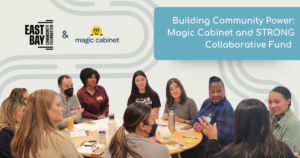Are Young Philanthropists Driving Participatory Philanthropy?
With $68 trillion coming their way, Millennial and Gen Z donors are pushing grassroots models

This article is reposted from Proximate, our independent media partner.
Growing up in her great-grandparents sprawling house in a Baltimore suburb and attending private school, Kate Poole always had a sense that her family had money. But it wasn’t until her parents told her not to bother with college financial aid applications that she started to sense how much.
It didn’t take long for Poole to figure out that she wanted to give her money away. It took her a bit longer, however, to land on the philosophy of how she should do it.
But with the help of peers at Resource Generation and other communities, she developed her approach to wealth redistribution: it should happen without the expectation of a financial return, and while ceding control over exactly how resources are distributed.
Poole now leads Chordata Capital, an anticapitalist wealth management firm that helps high-net worth, mostly young clients get their money off Wall Street and into the hands, and control, of communities. Along with her co-founder Tiffany Brown, Poole works with clients who have access to a minimum of $5 million, and helps them move their money into cooperatives and community-controlled, participatory funds – like the Black Farmer Fund, which taps Black formers to decide how to invest in Black agricultural systems. Chordata Capital has already moved $64 million through these models.
For Poole, participatory funding is key to effective giving. “It’s not enough to just shift wealth,” she says. “We also have to shift power.”
Poole is one of a growing number of young donors embracing participatory and transformative philanthropy. Over the next thirty years, Baby Boomers are expected to pass down $68 trillion in assets to their Millennial and Gen Z heirs. This will be the largest wealth transfer in human history, and it will dramatically shake up the leadership of countless legacy foundations.
In conversations with young donors, it’s apparent that this next generation of philanthropic leaders is approaching philanthropy in a way that is sometimes radically different from their parents.
On the one hand, Millennial and Gen Z donors are pushing new, participatory approaches to grantmaking as they age into leadership of their families’ foundations. In Chicago, next-gen board members at the Conant Family Foundation pushed to create a community review team to distribute local grants; in New York, scions of John D. Rockefeller led a project to involve formerly incarcerated individuals in their family foundation’s grantmaking decisions.
On the other hand, young donors are using their wealth to seed new foundations, funds and organizations that are explicitly participatory – from Chordata Capital to the Diverse City Fund, a DC-based participatory grantmaking fund created by a group of activists and donors affiliated with Resource Generation.
“I think these new kinds of models we’re seeing are only possibly because of this generational shift that is coming,” said George Guerrero, the executive director of Just Futures, at the Yale Philanthropy Conference last month during a panel on next-gen giving. “And while most funders are still from the old guard, they’re getting ready to pass the mantle to a new generation.”
Resourcing a Generation
The origin story of Chordata Capital winds through Resource Generation, a hub for young people from backgrounds of privilege that helps them grapple with their wealth and figure out how to give their money away.
Resource Generation has 1,200 dues paying members, aged 18-35 and spread across 21 chapters around the country. Members identify as coming from backgrounds of “wealth and/or class privilege”, and are committed to the equitable distribution of “wealth, land, and power”.
Collectively, Resource Generation helps move roughly $100 million a year from donors’ pockets into social justice movements. But their role is also important as a convener of conversations about ways to move money differently. They have become a hub for conversations about participatory philanthropy, transformative investment principles and reparative philanthropy, and a place for young donors to “learn with peers and unpack issues of power and privilege.”
“We have social justice philanthropy principles that we ask our members to give by. And those principles are: give to grassroots organizations who are building power, which are led by people most impacted,” says Nora Leccese, the campaign director for Resource Generation. “The resources are out there, and it’s our job to just shift them into the movement.”
Kate Poole joined Resource Generation after being active in the Occupy Wall Street movement, and soon met their retreat director Tiffany Brown, who had formerly worked in social impact finance. The pair bonded over their shared frustration with establishment philanthropy, and together created Chordata Capital, which now serves several Resource Generation clients.
Resource Generation is just one of several peer networks of young people from backgrounds of privilege who want to challenge the system that created their privilege. The nonprofit 21/64 provides multigenerational advising and training for young people coming into leadership of their family offices. Old Money New System, created in 2016 by a group of Resource Generation members, is creating a shared blueprint for non-extractive finance among the newly wealthy and the activists who share their values.
When young donors age out, they can go to places like Solidaire, which often takes in Resource Generation members once they turn 36, or hubs like Justice Funders that help donors of all ages approach philanthropy from the lens of a just transition.
Activist Philanthropists?
Of course, next-gen donors are not yet in control of that $68 trillion that will be transferred – not even close. As of 2021, less than 10 percent of nonprofit board members were under 35 years of age, and the numbers are likely comparable for grantmaking organizations.
That means that young donors have an uphill battle to convince their parents’ generation to consider new approaches to giving. Speaking with several next-gen donors, we heard that even when a family member ages into a foundation, they still face entrenched ideas of how philanthropy should work – and work in the shadow of legacy mega-foundations like Rockefeller and Gates that defiantly take a top-down approach.
At Resource Generation, Poole and Brown kept meeting other young donors who were coming up with exciting ideas to redistribute wealth directly to communities. When they tried to execute them, however, they ran up against wealth managers — or parents — who told them their ideas were unrealistic.
Poole shared that Yyoung donors are often advised that larger foundations are a safer bet, that smaller donations are sufficient, and that maintaining a degree of control over how your money is used is wise. In some cases, young people get blocked by trusts with clauses that mandate a certain amount of growth.
That’s where young donors find themselves playing a role as activist philanthropists – proactively educating their parents’ generation to consider new models.
For some, this advocacy mirrors a generational battle during the 1970’s and ‘80s, another moment of wealth transfer and of tension between the old and new guards. One of the spiritual precursors to Resource Generation is The Funding Exchange, a collective of young heirs of great fortunes that came together in the late 1970’s. The group’s members had grown up in the turbulence of great social change, from the civil rights movement to the Vietnam War, and believed in a more social justice-oriented, grassroots approach to grantmaking. All together, Funding Exchange members founded a total of 16 local participatory grantmaking funds around the country.
Funding Exchange members saw themselves as philanthropy activists as well as practitioners, attending events like the 1975 meeting of the Council on Foundations, where one FEX leader challenged the audience to rethink “how power is distributed in our society, how it is achieved and maintained, and for whose benefit it is used.”
For Marjorie Fine, who worked for years as executive director of the FEX-affiliated North Star Fund and served on FEX’s board, this generation’s donors are playing a familiar role – responding to a moment of great upheaval by trying to shake up philanthropy.
“[Now] we have grandchildren of Funding Exchange that have been raised up,” she says. She is optimistic about the support resources that exist this time around. “[Back then] there wasn’t a Solidaire, there wasn’t a Resource Generation, there were almost no other places that were organizing funders and donors.”
Leccese shared how the Resource Generation team helps their members break down the resistance they face, into “logistical” and “emotional” barriers. There are the nuts and bolts, such as navigating the legal barriers of accessing a complicated trust – and then there are the complicated feelings that can come with giving money away, such as the anxiety about the future. Resource Generation is prepared to help young donors navigate both conversations.
“It is such a paradox, but people who have disproportionate wealth and power in society often feel like they really don’t have agency about how to spend the money,” says Lecesse. “The biggest key to supporting people to be able to redistribute wealth is the assurance and reality that they’re not doing it alone.”




